This is easy for me to perform in TSQL, but I'm just sitting here banging my head against the desk trying to get it to work in EF4!
I have a table, lets call it TestData. It has fields, say: DataTypeID, Name, DataValue.
DataTypeID, Name, DataValue
1,"Data 1","Value1"
1,"Data 1","Value2"
2,"Data 1","Value3"
3,"Data 1","Value4"
I want to group on DataID/Name, and concatenate DataValue into a CSV string. The desired result should contain -
DataTypeID, Name, DataValues
1,"Data 1","Value1,Value2"
2,"Data 1","Value3"
3,"Data 1","Value4"
Now, here's how I'm trying to do it -
var query = (from t in context.TestData
group h by new { DataTypeID = h.DataTypeID, Name = h.Name } into g
select new
{
DataTypeID = g.Key.DataTypeID,
Name = g.Key.Name,
DataValues = (string)g.Aggregate("", (a, b) => (a != "" ? "," : "") + b.DataValue),
}).ToList()
The problem is that LINQ to Entities does not know how to convert this into SQL. This is part of a union of 3 LINQ queries, and I'd really like it to keep it that way. I imagine that I could retrieve the data and then perform the aggregate later. For performance reasons, that wouldn't work for my app. I also considered using a SQL server function. But that just doesn't seem "right" in the EF4 world.
Anyone care to take a crack at this?
